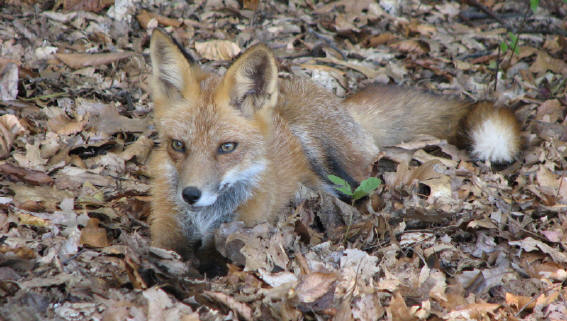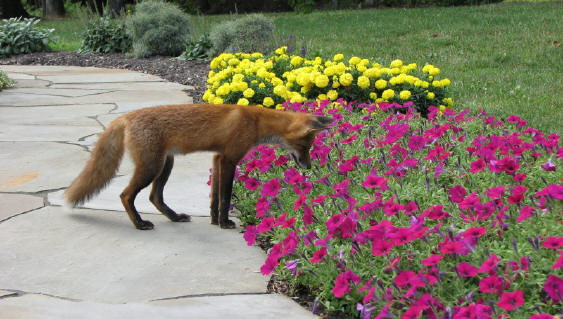 She came into our yard one evening as my husband and I were sitting on our front porch. As she traveled through our yard and flower beds, she seemed more interested in play than in us. She was gorgeous! She had dark brown ears
and legs, the classic large and bushy tail with a white tip on the end of it that matched her fluffy white chest. Her coat shimmered in the sunshine with its warm copper red tones. Her amber eyes were hypnotizing.
She came into our yard one evening as my husband and I were sitting on our front porch. As she traveled through our yard and flower beds, she seemed more interested in play than in us. She was gorgeous! She had dark brown ears
and legs, the classic large and bushy tail with a white tip on the end of it that matched her fluffy white chest. Her coat shimmered in the sunshine with its warm copper red tones. Her amber eyes were hypnotizing.
Since that first sighting in the middle of August, this young red fox regularly does her tour through our yard, walkways, driveway, woods and fields. She has now become so used to us being in her territory that she often plops down in the grass to watch us do whatever it is we happen to be doing. We
do not feed her, other than the sunflower seeds she gets from the ground feeder and the squirrels that aren‘t fast enough. Nor have we tried to touch her, although I think we could, with very little effort. Since she was such a frequent visitor, we decided to name her. She was funny and had beautiful red hair, so it seemed
logical to name her Lucy.

Observing Lucy’s behavior has been quite interesting. She uses her teeth to gently bite whatever she sees. It seems to be how she feels what it is. We watched her bite on our plastic lawn chair and then deciding it was okay, she jumped up onto it and sat down. What a funny sight to see a fox sitting
on a chair in the middle of the yard. We’ve watched her sleeping soundly at the edge of our lawn next to the woods as the warm sunshine lit up her shiny coat. Contrary to popular belief, foxes generally do not live in a den unless they are rearing young. They usually sleep in a protected area but on the ground. Their large
tail covers their nose and feet and keeps them warm, even when the weather is stormy.
We’ve watched her burying various dead critters in our flower beds, which she later digs up and eats. Foxes are known to gather more food than they can eat and they store the rest in various places within their territory. This leads to their reputation as murderers because they kill more than they
can eat. I guess it’s their assurance they won’t go hungry. They will eat just about anything, including bugs, beetles, mice, voles, birds, squirrels, and other small mammals, live or dead. In addition, they will eat fruits, berries and even sunflower seeds.

Foxes are susceptible to a variety of diseases, including mange, distemper, and rabies. They are most prone to these diseases when their populations are high. It’s nature’s way of controlling the population. They generally breed in January and February and they bear from four to ten kits, less than
two months later. The mother stays with the young while the father brings them food until they are old enough to travel with their parents on hunts. By September, the young are forced out to find new territories of their own.
Lucy regularly stops by and wants to have some fun. She will sometimes play chase with my husband, Kenny. He chases her around the trees and when he stops and turns to run, she immediately starts chasing him. We gave her a tennis ball, which she loves. She tosses it up in the air and then pounces on
it. She’s also a little thief. She has stolen gloves left by the fire pit, a boot left outside by my granddaughter, and a couple of other things we forgot to bring inside. We managed to find most of the items, usually under our willow tree. It’s obviously a fun game to her.
We are very grateful to have had such an up close and personal experience with this lovely wild beauty.
So, is she the sly, murderous, cunning animal of lore or is she an intelligent, curious, and playful creature that only seeks to survive and be fortunate enough to create a new generation? With a lifespan in the wild of only one to three years, the odds are against her. But, our dream is that she
will get lucky enough to survive, have babies and bring them to us to show them off. What a treat that would be!
Read other articles on birds, wildlife & beneficial insects
Read other article by Pam Van Pelt